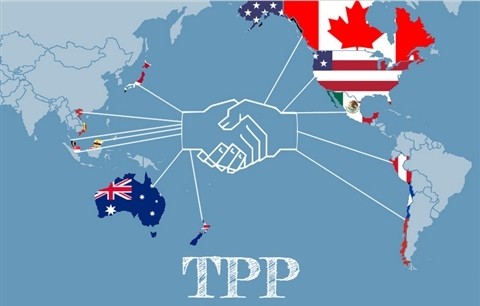(VOVworld) – President Donald Trump signed an executive order withdrawing the US from the Trans-Pacific Partnership (TPP) deal on Monday, realizing a promise from his campaign last year. This new generation trade agreement is now on the verge of collapse.
 |
| (Source: wikipedia) |
The 12-member TPP, which was considered a “lodestar” for global trade, will only take effect if it gets the parliamentary approval of at least 6 member countries, which should account for 86% of the GDP of all members. The US alone makes up 60% of the total GDP.
Reason behind US withdrawal
TPP members include Australia, Brunei, Canada, Chile, Japan, Malaysia, Mexico, New Zealand, Peru, Singapore, the US, and Vietnam. In October 2015, the US and other 11 members reached a final deal, which is in a 2-year period of parliamentary consideration.
During their presidential campaigns, both Donald Trump and Hillary Clinton voiced their opposition to the TPP, one of the major legacies of Barack Obama. Americans have been feeling the adverse effects of globalization, which are part of reason the UK is leaving the EU. Since the global financial crisis in 2008, the US economy has recovered slowly, but has seen growing income and social inequality and shrinking production.
Trump plans to impose 35% tariff on imports from Mexico and 40% on goods from China. He strongly opposes the TPP, calling it a “horrible deal.”
Future of new generation free trade deal
The world community has had mixed reaction to the US withdrawal from TPP. Japan said it will "take every opportunity" to convince President Trump of the deal’s merit. New Zealand is discussing Plan B to include China in the TPP. Germany said its businesses will try to seize business opportunities in Asia and South America created by US protectionism.
Within the US, there has been strong pushback. On Monday, John McCain, Chairman of the Senate Armed Services Committee, called the withdrawal a “grave mistake.”
Besides the economic aspects, the TPP is geo-politically significant as it includes the principle of intellectual property, dispute resolution, and the role of state-owned enterprises. If the deal falls through, the world economy may not suffer a big loss. It might even pave the way for better solutions. But economists are worried that Obama’s efforts during his 8-year presidency to increase US influence in the Asia-Pacific region will go to waste. China is ready to fill the gap vacated by the US as the region’s leader. China, which is not a member of TPP, is pushing a Regional Comprehensive Economic Partnership Agreement between the 10 ASEAN members plus 6 neighbors: Australia, China, India, Japan, the Republic of Korea, and New Zealand. Once the deal is completed, China will open the door for Latin American countries to join its “One belt, one road” initiative.
The US withdrawal from TPP does not mean the ambitious plan will come to an end. Other TPP members are considering forging ahead without the US. In the long run, though, the US economy and global anti-protectionism are bound to suffer.